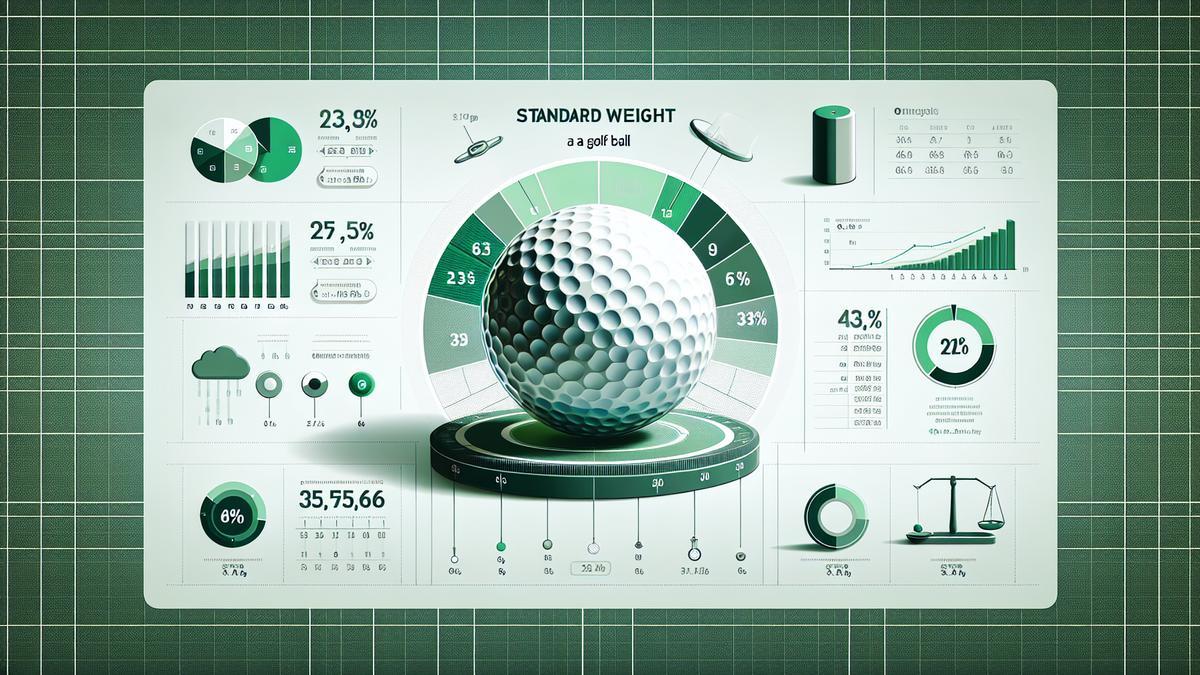Are you curious about how much does a golf ball weigh? You’re in the right spot! This article will explore golf ball weights and how they impact your game. From the standard weight to differences across brands, you’ll discover everything you need to know about golf ball weight, density, and how it affects your swing. So, let’s dive in and learn how understanding your golf ball can help you play better!
Key Points to Remember
-
- A standard golf ball weighs about 45.93 grams.
-
- That’s roughly 1.62 ounces in weight.
-
- Golf balls must meet specific rules to be used in tournaments.
-
- Different types of golf balls can weigh slightly different amounts.
-
- Always check the weight before your game for the best performance.
Understanding the Average Golf Ball Weight
What is the Standard Golf Ball Weight?
When you pick up a golf ball, have you ever wondered how much it weighs? The standard weight for a golf ball is 1.62 ounces, which is about 45.93 grams. The Rules of Golf, established by the USGA (United States Golf Association) and R&A (Royal and Ancient Golf Club), set this weight.
This weight is crucial for a few reasons. First, it helps maintain consistency in play. Imagine if every ball weighed differently; it would be like trying to hit a moving target! The standard weight helps keep things fair and square on the course.
How Much Does a Golf Ball Weigh Compared to Other Balls?
Now, let’s compare the weight of a golf ball with that of other popular sports balls. This will give you a better idea of how it compares.
Here’s a quick breakdown:
| Type of Ball | Weight (Ounces) | Weight (Grams) |
|---|---|---|
| Golf Ball | 1.62 | 45.93 |
| Tennis Ball | 2.09 | 59.43 |
| Baseball | 5.00 | 142.00 |
| Basketball | 22.00 | 623.69 |
| Soccer Ball | 14.11 | 400.00 |
As you can see, a golf ball is quite light compared to a baseball or a basketball. This lighter weight allows for a different type of play. When you hit a golf ball, it flies through the air with a different feel than a heavier ball would.
Discover the Weight of a Golf Ball in Grams
To understand the weight of a golf ball in grams, let’s break it down a bit more. The golf ball weighs 45.93 grams. This number is significant because it affects how the ball travels when you hit it.
Here are some interesting points about the weight of a golf ball:
-
- Lightweight Design: The lighter weight helps the ball travel farther when struck with a club.
-
- Material Matters: Golf balls are made of rubber and other materials that contribute to their weight and performance.
-
- Impact on Performance: A lighter ball can achieve higher speeds, making it an essential factor in the game.
Why Weight Matters in Golf
The weight of a golf ball plays a significant role in how you play. Here’s why:
-
- Distance: A lighter ball can travel farther when hit correctly. This means you can reach the green in fewer strokes.
-
- Control: The standard weight allows golfers to have better control over their shots. You can feel how the club interacts with the ball.
-
- Spin: The weight also affects how much spin you can put on the ball. More spin can help you control your shots, especially around the greens.
The Science Behind the Weight
Have you ever thought about the science behind the weight of a golf ball? It’s fascinating! The design and materials used in making a golf ball are meticulously chosen to achieve that standard weight.
-
- Core: The core of a golf ball is often made of rubber. This material is lightweight and gives the ball its bounce.
-
- Cover: The outer cover can be made from different materials, like Surlyn or urethane, which can also slightly affect the weight.
The Impact of Golf Ball Weight on Performance
How Much Does a Golf Ball Weigh Affect Your Game?
Every little detail can make a difference when you step onto the golf course. One of those details is the weight of the golf ball. Most golf balls weigh about 1.62 ounces (45.93 grams). But why does this number matter? Well, the weight of a golf ball affects how it flies through the air, how far it travels, and how it behaves when it hits the ground.
Imagine you’re on the tee, ready to take that perfect shot. Using a ball that’s lighter than the standard weight might soar higher but could lose distance. A heavier ball might not go as high but can travel farther. So, knowing the weight can help you choose the right ball for your style of play.
The Role of Golf Ball Density in Distance and Control
Golf ball density is another piece of the puzzle. Density refers to how compact the ball is. A denser ball can provide better control and a more solid feel. This means when you hit the ball, it feels more connected to your club, giving you a better chance to guide it where you want it to go.
Here’s a simple table to show how density and weight can influence your game:
| Golf Ball Weight | Density | Effect on Distance | Effect on Control |
|---|---|---|---|
| Lighter (1.55 oz) | Low | Higher trajectory | Less control |
| Standard (1.62 oz) | Medium | Balanced distance | Good control |
| Heavier (1.68 oz) | High | Lower trajectory | More control |
As you can see, each weight and density combination can lead to different outcomes. Finding the right balance can help you hit those long drives and precise approaches.
Why Knowing the Golf Ball Weight Matters for Your Swing
When you swing your club, the ball’s weight plays a big role. If you’re swinging a driver, you want a ball that can handle the speed and power you generate. A heavier ball can absorb that energy better, leading to more distance. On the flip side, if you’re using a wedge for a short shot, a lighter ball might help you get that higher launch angle you want.
Here are some key points to consider about golf ball weight:
-
- Swing Speed: If you have a faster swing speed, a heavier ball can help maintain control.
-
- Shot Type: For long drives, heavier balls can help with distance; for short chips, lighter balls can help with loft.
-
- Personal Preference: Everyone has a different feel. Some players prefer the solid feel of a heavier ball, while others like the responsiveness of a lighter one.
The Sweet Spot: Finding Your Ideal Golf Ball Weight
Finding the right ball weight for your game is like finding the right pair of shoes. It may take some time, but you’ll feel the difference once you find it. Here are some tips to help you find your sweet spot:
-
- Experiment: Try different weights during practice. Please pay attention to how they feel when you hit them.
-
- Track Your Shots: Record your distances and accuracy with different balls. This will help you determine what works best for your game.
-
- Consult with Professionals: Don’t hesitate to ask a golf pro for advice. They can help you understand how weight affects your performance.
Golf Ball Specifications You Should Know
What Are the Regulations for Golf Ball Weight?
When you step onto the golf course, you might not think about the weight of your golf ball, but it plays a crucial role in your game. According to the United States Golf Association (USGA), a golf ball must weigh no more than 1.620 ounces (45.93 grams). This regulation is in place to keep the game fair and consistent for everyone, so you can focus on your swing instead of worrying about the ball’s weight.
How Much Does a Golf Ball Weigh in Different Conditions?
You might wonder if a golf ball’s weight changes with different conditions. The short answer is not really. A standard golf ball will weigh the same regardless of temperature, humidity, or altitude. However, the performance of the ball can vary based on these conditions. For example, a ball may travel farther in dry weather than in humid conditions, but its weight remains constant.
Here’s a quick look at how various conditions can affect your game, even if the ball’s weight stays the same:
| Condition | Effect on Performance |
|---|---|
| Temperature | Warmer temps can make the ball fly farther. |
| Humidity | High humidity can affect distance. |
| Altitude | Higher altitudes can lead to longer shots. |
Understanding Golf Equipment Weight and Its Importance
It’s important to understand that while the ball’s weight is regulated, the weight of your golf clubs and other equipment can also affect your performance. Lighter clubs can help you swing faster, while heavier ones can provide more control. Finding the right balance is vital to improving your game.
The Weight of Golf Clubs
The weight of golf clubs varies based on the type and brand. Here’s a quick overview:
| Type of Club | Average Weight |
|---|---|
| Driver | 300-320 grams |
| Iron | 250-280 grams |
| Putter | 300-400 grams |
Comparing Golf Ball Weights Across Brands
How Much Does a Golf Ball Weigh from Different Manufacturers?
When you step onto the golf course, you might not think about the weight of your golf ball, but it can make a difference. Golf balls typically weigh around 1.62 ounces (45.93 grams). However, there may be slight variations in different manufacturers. Let’s dive into how much golf balls weigh from some famous brands.
| Brand | Weight (oz) | Weight (grams) |
|---|---|---|
| Titleist | 1.62 | 45.93 |
| Callaway | 1.62 | 45.93 |
| TaylorMade | 1.62 | 45.93 |
| Bridgestone | 1.62 | 45.93 |
| Srixon | 1.62 | 45.93 |
| Wilson | 1.62 | 45.93 |
| Mizuno | 1.62 | 45.93 |
| Pinnacle | 1.62 | 45.93 |
As you can see, most popular brands stick to the standard weight. But, some brands may offer specialty balls that weigh slightly more or less. These variations can affect your game, especially if you want a specific feel or performance.
Golf Ball Weight Comparison: What Should You Look For?
When comparing golf balls, it’s essential to consider a few factors that can impact your swing and overall performance. Here are some key points to keep in mind:
-
- Weight Consistency: Most golf balls weigh the same, but slight differences can exist. Consistency in weight can lead to more predictable performance.
-
- Feel and Control: Heavier balls may feel different during your swing. You might prefer a ball that feels solid at impact. Lighter balls can sometimes feel softer.
-
- Distance vs. Accuracy: Some players favor distance, while others prioritize accuracy. Heavier balls can provide more control, while lighter ones may help with longer drives.
-
- Ball Construction: The materials used in the ball can affect its weight. Multi-layer balls may have different weights compared to two-piece balls.
Finding the Right Golf Ball Weight for Your Style
Finding the right ball for your game is like finding the perfect pair of shoes. It’s all about what feels right for you. Here’s how you can determine the best golf ball weight for your style:
-
- Try Different Brands: Don’t be afraid to experiment with various brands. Visit your local pro shop or sporting goods store and pick up a few different types.
-
- Practice with Different Weights: When you practice, use balls of different weights. Please pay attention to how they feel during your swing and how they perform on the green.
-
- Ask for Recommendations: Talk to fellow golfers or your local pro. They can offer insights based on their experiences with different brands and weights.
-
- Consider Your Swing Speed: If you have a faster swing speed, you might prefer a heavier ball for better control. If your swing is slower, a lighter ball could help you achieve more distance.
-
- Analyze Your Game: Keep track of your performance with different balls. Which ones feel best? Which ones give you the best results? This can help you narrow down your choices.
Frequently asked questions
How much does a golf ball weigh?
A standard golf ball weighs around 1.62 ounces (45.93 grams).
Can a golf ball weigh more or less?
Yes, but it shouldn’t be more than 1.62 ounces. That’s the rule!
Why is the weight of a golf ball significant?
Weight affects how far and straight you can hit the ball. It matters a lot!
What happens if a golf ball is too heavy?
If it’s too heavy, it won’t fly well. You’ll struggle to hit it far!
How do I check a golf ball’s weight?
You can weigh it on a scale. Just make sure your scale is accurate!






Leave a Reply